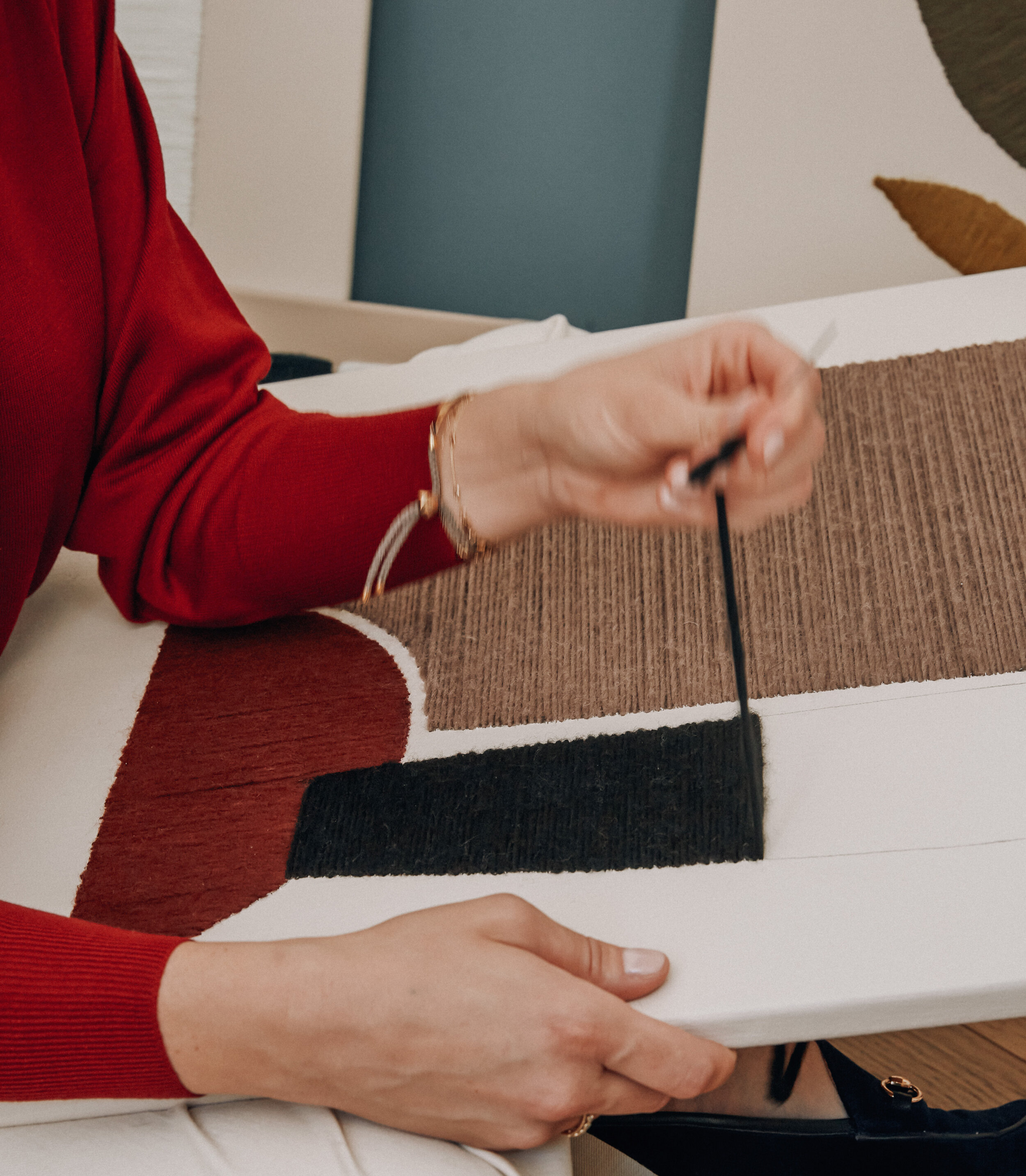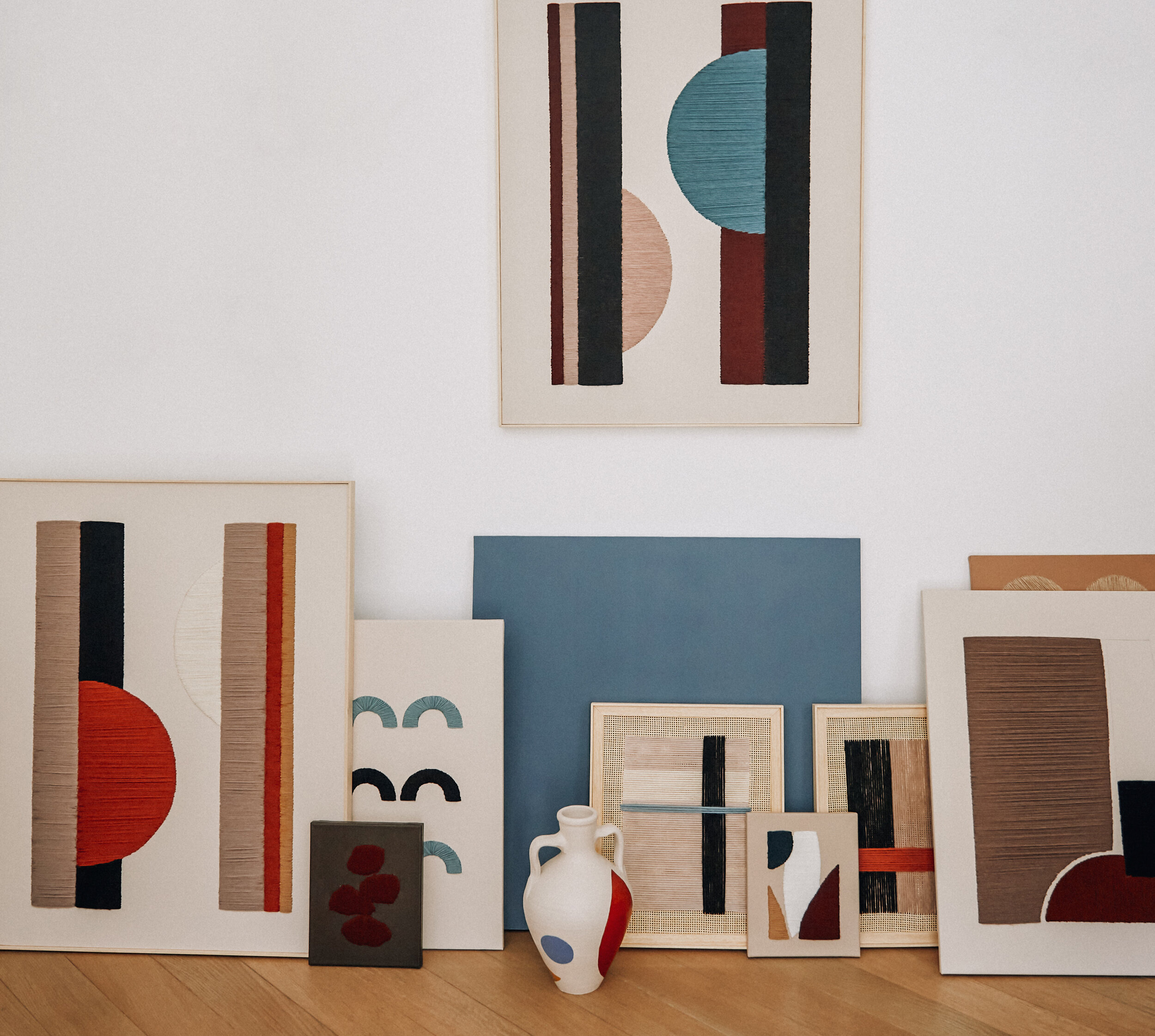Mid-century Modern sophistication
Words: Tous Mag | Image Credits: © Kanica Weaving |
Fibre artist Laura Vargas Llanas - Kanica Weaving’s brain child - uses beautifully crafted block coloured geometric shapes to bring her woven canvases to life. Influenced by the likes of Sonia Delaunay, Alexander Calder, Henri Matisse and the Bauhaus Movement, each piece is individually handcrafted with natural and ethically sourced fibres, such as merino and alpaca wool, cotton and jute. We’re pleased to say that gone are the days of your family’s embroidered crest hanging in your bedroom - though they’ll remain a prized possession, always - with a surge of contemporary fibre artists using techniques that have been, traditionally, passed through generations to take tapestry and weaving to new aesthetic heights.
Kanica Weaving’s bespoke wool on canvas pieces are delightfully stylish. They’ll add a texture to your walls that can’t be achieved from a painting, tying all your home furnishings together to get that elegant yet distinctly unique look. Mid-century Modern really has never looked so sophisticated, we’re swooning particularly hard… and don’t even get us started on Laura’s dreamy wrap boiler suit (pictured above).
Tous Mag caught up with the artist herself, read the full interview, below!
Tous Mag: Who are you and what do you do?
Laura Vargas Llanas: I am the founder and multidisciplinary creative behind Kanica, a collection of fibre and decorative artworks. I individually design and handcraft every piece with natural fibres, such as merino and alpaca wool, cotton and jute. I value craftsmanship and a design aesthetics in my work, always seeking to find the balance between those two disciplines.
Tous Mag: Could you tell us something people might not know about you?
Laura Vargas Llanas: I am addicted to writing lists (and obviously it is very rewarding when I cross them over). I am extremely organised and I think this is key when you are working on your own. I cover all aspects of my practice; from design, to production, social media, shipping, accounting … so I need to have a real 360° control over everything, if I want things to run smoothly.
Tous Mag: What wouldn’t you do without, in life?
Laura Vargas Llanas: That is a tricky question, but if I had to choose something material, I would say my phone (and a wifi connection of course). It keeps me connected to my family and friends, allows me to take pictures, and edit them, I listen to the radio and podcasts all the time, I write my to-do lists, reminders, subscriptions to news, magazines, etc. basically it is an essential tool for me.
And of course, I could not live without my dog Lucio, a German shorthaired pointer.
Tous Mag: When did you know you wanted to be an artist/designer?
Laura Vargas Llanas: Since a very young age I have always been drawn to creating things with my hands and I always knew I wanted to work within a creative field, although it was not until 2015 that I founded Kanica and not until 2018 that it became a full time occupation.
Tous Mag: What was your route to becoming an artist/designer?
Laura Vargas Llanas: I have a background in History of Art and for many years I worked in the art industry, mainly in commercial art galleries. At first, my creative practice was more of a hobby but when I moved back to Spain, after living abroad for many years, I decided to focus exclusively on my Kanica project.
Tous Mag: What initially attracted you to textiles as a medium?
Laura Vargas Llanas: While studying history of art I discovered the work of Anni Albers and the weavers of the Bauhaus School, and their belief that every craft object has the potential to be art. I then discovered the work of contemporary fibre artist Sheila Hicks and I was completely drawn by her transformations and studies of textiles into works of art. I wanted to explore those notions myself and translate them into my own vocabulary, with a focus on decorative design.
Tous Mag: How has your practice changed over time?
Laura Vargas Llanas: The ‘essence’ of my practice remains the same: to reinvent a traditional craft such as embroidery, for instance, and translate it into a decorative and design object. However, my work has evolved by experimenting with different materials, going from weaving to embroidery, from small to large formats, as well as exploring different disciplines and dimensions, for example, terracotta amphoras.
Tous Mag: If you could work within a past art movement, which would it be?
Laura Vargas Llanas: It would most probably be the Bauhaus Movement. I would have loved to attend the Bauhaus School and be surrounded by artists that I greatly admire, such as Anni Albers, Josef Frank, Paul Klee, among many others. I am aware that it must have been extremely hard to live after WWI, but from my perspective, today, I find there is something very alluring about the 20s and 30s. There was a belief that art embodied universal principles, and modernism put its faith in the ideal that art and design could fundamentally transform and affect life.
Tous Mag: What are you working on at the moment?
Laura Vargas Llanas: Currently I am working on several projects: developing new mini collections (unique pieces at affordable prices, as I believe art should be accessible to everyone), working on various commissioned pieces. This aspect of Kanica I particularly enjoy as I love working on the creative process directly with the client and I am developing a new collection of limited edition amphoras, that will revisit traditional mediterranean crafts with contemporary designs.
Tous Mag: If we asked you to give an important message to our readers, what would it be?
Laura Vargas Llanas: There is a quote by Atticus that reads “Art takes time - Monet grew his gardens, before he painted them”. This might sound like a cliché but I do believe it takes a lot of hard work, perseverance and patience to achieve your goals, whatever those may be.
As designers and creatives, we need to continue stepping outside of our comfort zones, pushing the definition of design and craftsmanship, merging disciplines and exploring different mediums to find what suits us best. Along the way, it is important to be open to suggestions and feedback, and adapt to the environment that surrounds us, especially during these uncertain times. But most importantly, you always need to believe in your work.








